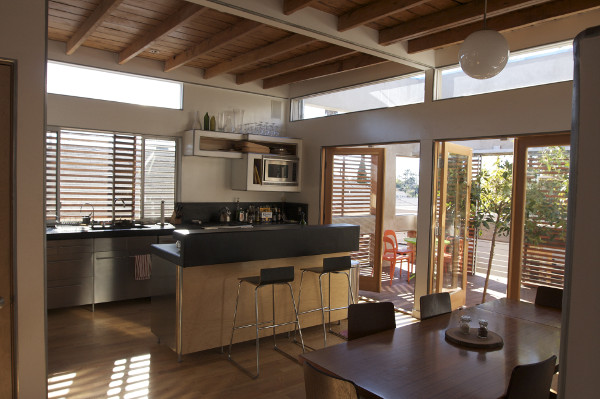Research and sustainability create increasingly innovative and surprising materials

The search for innovative materials for use in architecture and interior design never ceases to amaze. The combination of well-known materials and original processing techniques gives rise to new materials that can be used both in the structure of buildings and in interior decoration. From vegetable skins to soundproofing panels made from old jeans and tiles made from coffee grounds, homes are becoming increasingly sustainable and recycling-friendly.
New solutions for building structures
While the watchwords for traditional materials are sustainability and recovery, when we talk about innovative materials we must also consider the use of unusual raw materials and advanced technological systems that transform materials into something never seen before.
The entire architectural project can in fact be based on the use of innovative materials. Starting with the building’s structure, made with “smart” bricks obtained from waste materials recovered from quarries or demolition sites. There are also organic solutions. There are indeed curious bricks made from fibres obtained from certain species of mushrooms. And yet, as well as having a low environmental impact, this type of brick has exceptional characteristics of resistance and energy efficiency.
It is well known that energy dispersion and temperature regulation is one of the factors that most affects living comfort. So, the use of technological materials for the bricks and insulating panels used in the construction of the building can give a big hand in improving the energy efficiency class of the structure. While at the same time protecting the environment.
Insulating and sound absorbing panels can be made from a long list of materials. Among the most versatile and convenient to use are panels made from recycled textile materials, particularly wool and cotton.
The characteristics of plant cellulose and waste from rice and hemp processing have long been appreciated by the building industry. In particular, their insulating and heat-regulating qualities are exploited in the production of plasters made from a mixture of lime and vegetable fibres. The strength and versatility of these materials allows them to be used both indoors and outdoors.
Researchers are not only creating new materials, but also working on new possible applications for already known materials. This approach has led, for example, to the development of transparent wood, which is made by specially treating wood fibres. This material can be used to replace glass in windows or as decorative panels.
Design decorations from vegetable waste and recovered fabrics
Recovering products that seem to have reached the end of their life cycle is a priority for architects and designers who pay attention to the impact our daily choices have on the environment and pollution.
The new materials proposed by companies and designers sensitive to this issue show us that great ideas can be born from waste. Ideas that can then be applied to home decoration. One example is vegetable skins made from fruit and leaf waste. The fibres, properly treated in the laboratory, take on characteristics very similar to animal skin. The tanning process is carried out in the traditional way and makes it possible to obtain skins to be used for covering sofas, chairs and armchairs.
Tiles made from recycled materials destined for landfill can also be used for floor and wall coverings. From this point of view, textile fibres are a resource of enormous value. Old garments – made from natural or synthetic fibres – in combination with special resins and glues, become high-density and particularly resistant tiles, which can be used for floors or walls in bathrooms and kitchens.
Coffee grounds are one of the most surprising recovered materials. Once the coffee powder has been extracted from the beverage, it is processed together with polymeric compounds that thicken it and make it compact and resistant. The mixture is then used to make tiles and decorative panels of various sizes, which in many cases can be further recycled.
The biocompatibility and biodegradability of the materials chosen for furnishing projects are qualities to be taken into great consideration. Proposing these solutions to your customers is a good idea, not only when the customer specifically requests eco-friendly and sustainable furniture. Choosing furnishing solutions that respect the principles of the circular economy, as well as being good for the environment, allows you to create a truly unique and personalised project with a strong innovative character.
Choose a high-level carpentry.
We have over 50 years of experience! Contact Us
“Italian Interior Design sincew 1968”.
 Il Piccolo is a luxury joinery, specialised in interior design. We are a recognized brand, spokesman of the made in Italy all over the world.
Il Piccolo is a luxury joinery, specialised in interior design. We are a recognized brand, spokesman of the made in Italy all over the world.
For over 50 years, we have been serving the most demanding clients and the most innovative designers. We are reliable interpreters of the projects of architecture studios, which we work alongside as consultants on the latest in industrial design and as scouts for unique pieces to be included in furnishings, from modern antiques to contemporary art.
Our clients have a personal and direct relationship with us: this gives them the certainty of achieving their objectives, meeting tight deadlines and solving last-minute problems. The project leader, who is always one of the owners, also takes care of the logistics.
Each stage follows a precise path and is documented. From the plans to the prototyping, so that the best choices can be made from the outset: materials, colours, wood finishes and polishes, stucco effects. By contacting us, you can be sure of excellent customer care. CONTACT US!



